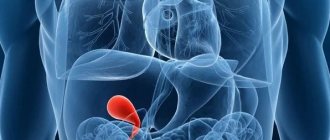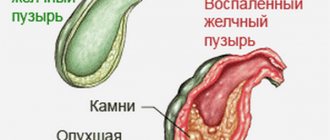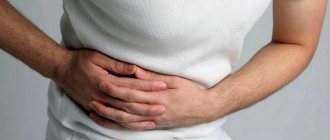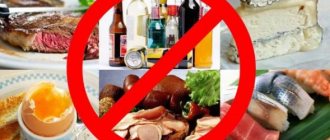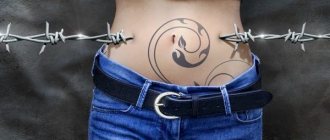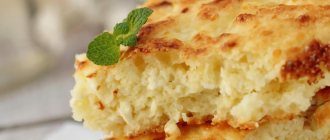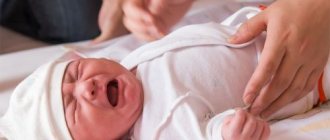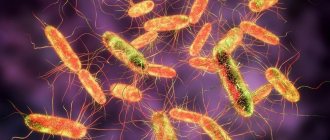A bend in the gallbladder in a child is a relatively common diagnostic finding during ultrasound examination. Anomalies in the structure of this organ occur in 6-8% of patients in the general population. The bending of the gallbladder also belongs to them and, according to the classification, is considered an anomaly of shape. To understand how this feature can affect the child’s body, you should familiarize yourself with the principles of normal functioning of the gallbladder.
What is a bent gallbladder in a child?
In a newborn child, changes in the shape of an organ are not always diagnosed. This is due to the fact that the pathology may well not manifest itself until a certain moment. Situations often occur when a congenital inflection of the gallbladder in children is not detected either during diagnosis in the maternity hospital or during adulthood. Many people diagnose the disease only by chance, conducting an ultrasound examination to identify other possible diseases. But often, due to the irregular shape of the organ, people experience certain symptoms, which, during examination, are confirmed as cholelithiasis and other dangerous diseases.
The gallbladder, when deformed, reduces its ability to fully accumulate bile. As a result, stagnation of bile in the ducts can form stones. Stones obstruct the flow of fluid through the channels and can lead to very serious consequences. One of them, with an extreme degree of development of the pathology, may be complete removal of the organ through surgery. This means that the body will be subjected to great overloads, and throughout life it will be necessary to reduce them, adhering to certain recommendations.
Many people know first-hand what a bend in an organ is, what consequences pathology can bring, and how one has to adapt to life in conditions of complete or partial dysfunction of one of the body’s parts. The disease is quite common, and therefore there are also quite a lot of treatment and prevention methods.
A bend in the gallbladder in a child is most often congenital. During pregnancy, for certain reasons, the organ does not develop fully. This may be due to an unhealthy lifestyle during gestation or heredity, as a result of which the baby has deviations from the moment of birth.
Why kinks occur, specific factors influencing the formation of an organ, in addition to heredity, have now been studied quite well by medicine. Tobacco smoking or, for example, taking medications not authorized by a doctor can easily affect the development of this pathology. Pathology can seriously undermine health; bending in the area of the organ body is especially dangerous. In cases where deformation appears precisely in this part of the bladder, surgical intervention is often performed.
Reasons for the formation of pathology
The characteristics of a biliary disorder can be identified by performing an ultrasound examination. And the reasons must be established individually in each case.
In some cases, an ultrasound examination can reveal a labile deformity in a child or adult. Also, the patient periodically experiences changes in the shape of the gallbladder body relative to its axis. This result appears when a person experiences increased physical activity. However, the organ returns to normal after some time and does not cause additional discomfort.
Important! A congenital type of disease is formed, as a rule, due to human genetic factors, as well as if disturbances and negative effects on the fetus occurred during the growth of the baby. In the medical field, it is not customary to classify congenital changes as diseases.
A congenital type of disease is formed, as a rule, due to human genetic factors
Such deformation is usually attributed to permanent form. Consequently, the baby in the womb is diagnosed with permanent kinking. In most cases, this characteristic does not bring much inconvenience to a person’s life. Sometimes at a young age this pathology goes away on its own. But there are situations when a change in the shape of the gallbladder will accompany a person constantly.
The acquired disease has a number of reasons that caused such a change in the organ:
- excess weight;
- high mobility of the bile organ, which is due to its incorrect location in the body;
- expansion of the size of internal organs;
- improper diet and nutrition;
- high physical activity, impetuous movements and turns;
- chronic stress;
- constantly being in a sitting position;
- complications of other diseases.
It is important to mention that bending the gallbladder is dangerous due to its complications. The disease can lead to dyskinesia, which, in turn, can develop into gallstone disease. Therefore, pathology must be given sufficient attention. It is important to follow the necessary decisions determined by the specialist so that the disease does not cause additional problems.
Excess weight in a child
The curvature of the gallbladder has its own characteristic features, which can be used to determine whether a child has a pathology.
Types of gallbladder kinks in children
The bends of the gallbladder in children are divided into several types - those obtained from the moment of birth and those that arise during life. Regardless of the nature of the pathology, deformation occurs in the following parts of the organ:
- in the cervical area,
- in the body area,
- in the bottom area.
The curved organ in the cervical part is most common . Such deformation can seriously harm the entire digestive system. A child's gallbladder may take on a hook-like shape. There is an opinion that bending in the area of the body of the organ is most dangerous. Volvulus may well cause a tissue breakthrough, which will inevitably lead to acute peritonitis of the abdominal cavity. Without urgent medical attention, such a scenario can lead to death. It is important to identify the functional inflection of the gallbladder in a child as early as possible. The main symptoms are:
- pain under the ribs on the right side of the chest,
- nausea,
- vomit,
- changes in skin color,
- a sharp decrease in body weight,
- loss of appetite,
- allergy.
A bent organ will definitely make itself felt . Many factors accumulate and lead to complications, most often serious. One of the consequences may be biliary cirrhosis of the liver. If a child’s gallbladder is curved from birth, there is a high probability that there are pathologies in other areas of the body’s functioning. The most common are:
- heart disease,
- pathologies in the structure of the skull,
- disorders in the structure of the spine,
- malfunctions of the musculoskeletal system.
The acquired nature of the disease also provokes a large number of complications. Twisting of the organ leads to stagnation of bile and the formation of stones, thereby disrupting the digestion process and developing many diseases of the intestines, stomach, and liver.
In addition to the already described variants of organ deformation, there are also some less common ones. One of them is the labile bend. The gallbladder is twisted in such a way that it can rotate. Wrapping an organ most often occurs as a result of some kind of physical activity and can only temporarily change its shape.
There is also a double bend of the gallbladder, or S-shaped. It occurs in the neck or body area. Deformed in this way, it becomes hook-shaped.
Diagnosis of the disease
The most accurate method for diagnosing a kinked gallbladder is an ultrasound examination of the organ. Ultrasound can reveal:
- size and localization of deformation;
- location and shape of the bend;
- gallstones;
- condition of the liver and bile ducts;
- type of pathology.
To determine the type of disease (congenital or acquired), a stress ultrasound is performed. The procedure includes an ultrasound scan, after which the small patient needs to eat an egg yolk to remove bile into the intestines. With congenital pathology, the deformation in the gallbladder does not change.
Radiography is used to clarify the diagnosis. The essence of the procedure: the introduction of radiocontrast (iodine) into the body by injection or orally. The liver has the ability to absorb particles of the substance and remove them with bile. The x-ray image clearly shows the bubble, but its ducts are poorly visible.
Causes of inflection
Congenital bending of the gallbladder in a child develops in the womb at 2-3 months of pregnancy. The reasons may be the following factors:
- smoking,
- alcohol consumption,
- unsuitable ecology,
- taking medications,
- limited physical activity,
- infectious diseases.
There is also a possibility that the pathology will be transmitted hereditarily from the mother . During pregnancy, an infection may occur that can harm the process of formation of the internal organ system. During pregnancy, the mother also runs the risk of gallbladder deformation. As body weight increases, the uterus enlarges, which puts pressure on the internal organs, resulting in a change in their shape. Another cause of congenital pathology can be the incorrect process of feeding a child. When switching from breast milk to other types of food, a bend in the gallbladder can sometimes occur. This happens because the organ begins to stretch and by the age of 3-4 years it becomes curved.
The acquired nature of the disease in children most often appears due to poor nutrition . For example, when you are with your child for a long time on a walk or on other errands outside the home, there is no way to eat on time. Then, upon coming home, children often overeat heavily. Sometimes to such an extent that they cannot even breathe fully. During this time, the following processes can occur in the body:
- with prolonged fasting, there is no outflow of bile due to the lack of need for it,
- after eating a large meal, the stomach becomes irregularly shaped and puts pressure on the gastrointestinal tract,
- With further food intake, the outflow of bile is disrupted.
Classification of gallbladder bends
Bladder bends are divided into congenital and acquired. According to the degree of stability, labile and fixed deformations are distinguished. The first type is typical for children. These are “temporary” changes that resolve themselves as the child grows and develops. They are rarely accompanied by the formation of dense fibrous “strands” in the muscles and disappear without a trace.
Fixed (stable) kinks are more often a congenital pathology. The change in the shape of the organ is pronounced. Depending on the location of the bend and the quantity, double, triple and even multiple bends are distinguished. The bubble can take the shape of a boomerang or hourglass. Double bends with a pronounced curvature are called S-shaped. This deformation is considered the most dangerous. It rarely goes away on its own.
Doctors classify the bends of the bladder according to their location. More common are curvatures between the fundus and body, neck and bile duct. Less commonly diagnosed are curvatures of the body of the bladder, the area between the body and the neck.
Symptoms
The bending of the gallbladder in children can be asymptomatic up to a certain point, but it can also make itself felt by the manifestation of symptoms. To a greater extent, signs of gallbladder bending appear between the ages of one and five years. Main symptoms:
- attacks of nausea and vomiting during and after meals,
- sharp pain in the abdomen and side,
- sleep disturbance,
- change in normal skin tone,
- fluctuations in body temperature.
A fixed bend will definitely make itself felt, most often expressed in the form of the indicated signs. If a child has a bend in the gallbladder in the fundus, the main symptom will be pain in the left side of the abdomen or in the center. It is necessary to pay attention to how the baby behaves; if his stomach hurts, he will be constantly irritated, and it is quite possible that he will not sleep enough. Problems with the gallbladder at this age definitely cannot be acquired. Only a doctor can diagnose a congenital pathology based on the symptoms and prescribe treatment, and a visit to whom should not be postponed under any circumstances.
Signs and symptoms
The presence of a deformity in a child may not manifest itself in any way, especially in the case of a functional bend. Symptoms begin to appear when the bladder enlarges or the outflow of bile is disrupted. A kink is often discovered accidentally during a routine ultrasound examination.
Symptoms appear when the biliary system malfunctions. In this case, symptoms such as:
- pain, feeling of heaviness in the right hypochondrium;
- nausea, possible vomiting after eating;
- light stool and dark urine;
- itching and yellowing of the skin;
- increased gas formation in the intestines.
The symptoms are due to stagnation of bile, which is caused by an excess. Information that states that symptoms depend on the location of the constriction is not reliable. Only a doctor using medical equipment can accurately determine the location of the pathology.
What is the danger of a bent gallbladder in a child?
A bend of the gallbladder in a child is most dangerous due to the development of new pathologies, and can also stop the full development of the baby. In children under 3 years of age, the body is not yet able to fully resist the progressive disease, so therapy and observation by a doctor will be extremely necessary. Complications that are caused by a bend in the gallbladder in a child:
- liver diseases,
- digestive disorders, which can result in diseases of this part of the body,
- pathology of skeletal bones.
Disease prognosis
Since accumulated bile interferes with the process of breaking down and digesting food, over time the level of fatty acids in the blood will begin to increase and, conversely, the rate of glucose oxidation will slow down. As a result, the following pathologies may begin to develop:
- Deterioration of vision.
- Dysfunction of the digestive organs.
- Decreased muscle tone.
- Formation of stones in the kidneys and gall bladder.
- Lag in general development.
With correctly defined therapy, the prognosis of the disease has a positive trend, and in many cases, as the child grows older, he gets rid of all the symptoms of the disease.
In the video, doctor Komarovsky explains what to do if a child has a deformed gallbladder.
When a persistent deformation of the gallbladder develops in a child, the disease progresses. Stagnation of bile increases the load on the organ, disrupts the digestion of food, and intoxication of the body occurs.
If a bend develops in childhood, this can subsequently lead to the formation of gallstones. However, in general, the prognosis for the inflection point is favorable. In the absence of other unfavorable factors, even persistent constriction of the gallbladder in a child may not affect the functions of the biliary system.
If the gall bladder is bent, the child should be under the supervision of a pediatrician. It is important to ensure that he strictly follows all the specialist’s recommendations.
▼We RECOMMEND YOU TO STUDY▼
Treatment
The doctor prescribes treatment for a bent gallbladder after an examination and it depends on the degree of development of the pathology and most often individually for each patient. A bend detected in a child at an early stage is most often treated prophylactically, observing how the body adapts to existing conditions. What you need to do first is to change your diet to what your doctor recommends. This approach will facilitate the work of the liver and gallbladder, which means that the less load on the deformed organ, the better. The treatment method will be mainly aimed at increasing the tone of the body and its ability to function fully. A specialist will treat with medications or surgical intervention only in the most serious cases.
Treatment Basics
To get rid of deformation, you should create optimal conditions for regular and complete outflow of bile. This is important for the prevention of stagnant processes and additional stretching of the walls of the organ. Diet therapy plays a key role. A proper diet and a rich diet with healthy foods ensures the optimal composition of bile and improves its rheological properties.
Regular meals contribute to the timely contraction of the bladder walls and the full release of secretions into the duodenum. It is important to prevent excessive synthesis of bile acids by liver cells. Accumulation of bile increases the risk of stone formation, dyskinesia, and blocked ducts.
Drug therapy consists of prescribing antispasmodics, cholekinetics, and hepatoprotectors. Medicines are selected individually, taking into account the characteristics of the pathology and the age of the patient. Self-medication is unacceptable.
It is possible to use phytotherapeutic measures. The synthesis and outflow of bile is favorably influenced by the use of rosehip decoction, tansy infusion, chamomile, and mint. Any herbs, the method of their use and dosage are also prescribed by the doctor.
To normalize the functioning of the gall bladder, physiotherapy and exercise therapy are prescribed. The procedures prevent the development of inflammation and relieve spasms of the ducts. Gymnastics are selected taking into account the shape of the bend. Regular exercise improves the flow of bile from “hard-to-reach” places and prevents the formation of flakes in the organ.
Drug therapy
The method, which involves treatment with tablets, is designed to eliminate symptoms, strengthen the immune system and help the child avoid surgery to remove an organ. Medicines will help relieve attacks of nausea and vomiting, reduce the intensity of abdominal pain and eliminate acute manifestations of pathology. The use of a drug such as “Hofitol” will be very effective when bending the gallbladder, which will become a catalyst for the complete outflow of bile.
In some cases, when the course of the disease resolves against the background of inflammation, antibiotics are prescribed. Traditional medicine can be beneficial in certain situations, but treatment by this method must be agreed with a doctor.
Gallbladder is normal
In a healthy person, this organ is usually pear-shaped or funnel-shaped. In young children, the gallbladder is shaped like a spindle. The shape gradually changes according to age. The structure of the gallbladder is divided into: bottom, body and neck.
The main function of the organ is the accumulation of bile. When there is a need to break down fatty foods, the walls of the bladder contract. Through the bile duct system, bile enters the duodenum through the sphincter of Oddi, located in its wall.
Diet is the key to quick recovery
Excluding foods harmful to the body from the diet and proper nutrition can support the functioning of the gallbladder and improve the general condition of the body. What should you avoid first:
- fried and fatty foods,
- dishes containing a large amount of spices,
- spicy food,
- coffee.
You can saturate your body with useful substances by using foods such as pumpkin. It is possible to prepare a lot of dishes from it, and also use the seeds of the fruit, which are also very healthy. Diet implies not only the consumption of certain foods or the exclusion of harmful ones, but also the correct diet. You need to eat 5-6 times a day, preferably in small portions.
Diet therapy for inflection of the gallbladder
According to many doctors, diet is the most optimal method of treating pathology. Children should eat 5 to 7 times a day in small portions. The interval between meals is approximately 4 hours.
During treatment of a GB bend, the following foods and drinks should be excluded from the child’s menu:
- Sausage, lard, smoked products.
- Spicy dishes with lots of spices.
- Canned vegetables, products.
- Milk fat or margarine.
- Snack products (chips, nuts, crackers, salted popcorn, etc.).
- Semi-finished products from meat, fish, vegetables, cereals, combined products.
- Sweet sodas.
- Dried dried apricots, prunes, raisins.
- Dishes from peas, beans, lentils.
- Honey, jam, chocolate products.
- Gum.
Diet is an important condition for the treatment of GB bending
It is recommended to include the following foods in the diet of a small patient:
- Meat (low-fat varieties).
- Fermented milk products with low fat content.
- Pasta made from durum wheat.
- Fish (low-fat varieties), seafood.
- Vegetable oils.
- Seasonal fruits, vegetables, berries.
- Cereals (buckwheat, oatmeal, rice, etc.).
Despite the restrictions, the child’s menu should be varied.
It is recommended to boil, steam, stew or bake foods without fat. Give preference to homemade dishes, as they do not contain harmful chemical additives (preservatives, dyes, stabilizers, etc.).
In addition, the child should consume foods rich in fiber every day.
Cereals perfectly absorb liver secretions. Therefore, it is recommended to prepare oatmeal for children with milk or water, as well as buckwheat or millet.
The child can enjoy crackers, Bird's Milk candies, marshmallows, and halva.
The patient is prohibited from consuming rich broths; it is better to give preference to soups with the addition of vegetables or cereals.
Your daily diet should include bananas, strawberries, plums, and apples (not sour varieties).
Advice from Dr. Komarovsky
The famous pediatrician Komarovsky recommends treating the bending of the gallbladder in a child by influencing the causes of the disease. The causes of cholecystitis lie in disruption of the biliary tract. The disease can also be a consequence of increased physical activity, sleep or eating disorders. Thus, treatment will be prescribed not only to relieve symptoms, but also to eliminate the reasons why the channels cannot fully fulfill their purpose.
Increased physical activity should be recommended by a doctor; in other cases, you should limit yourself to simple gymnastics. A video where a doctor talks about ways to resist the disease can be easily found on the Internet today.
Types of deformation
Conventionally, all causes leading to such dysfunctions of the bladder are divided into congenital, functional and acquired. It all depends only on the influence of what factors the deformation occurred.
Congenital
This bending of the gallbladder in children occurs due to abnormalities in the development of the embryo. The defect is discovered immediately after birth or by chance, during ultrasound, before the age of 1 year.
The possibility of a genetic predisposition to excesses has not been sufficiently studied, but this version deserves consideration. Deformities are usually found along with other birth defects.
A bend in the gallbladder found in a healthy baby does not always signal defects that arose in the womb. Often such deformation is a temporary consequence of active growth, so it is considered almost normal. The reason for kinks in children is the fairly rapid formation of organs, which changes their location.
A problem may arise when the baby is transferred to rough food. During this period, the load on the children's gall bladder increases greatly. Such bends are characterized by lability: they change location when the body position changes, and can disappear when standing up. The bend is temporary. As the child grows, it disappears without a trace, without leading to pathologies of the bile ducts and bladder.
Purchased
External factors lead to this type of torsion. Most common:
- Diseases of the biliary system (bile, its ducts). Chronic inflammation is the cause of the appearance of adhesions, narrowing the lumen of the growing bladder.
- Rapid weight loss, leading to prolapse of organs, becomes a potential provocateur of excesses.
- Physical inactivity. Frequent sitting causes a functional bend of the bladder, which disappears if the child stands up. Teenagers who spend a lot of time at the computer are most susceptible to this type of deformation.
- Incorrect nutrition. Malnutrition, obesity, and overeating are to blame for the displacement of abdominal organs, including the bile ducts and bladder.
- Excessive physical activity for a child.
The most reliable and safe method for detecting deformation of the gallbladder is ultrasound. It makes it possible to see not only the change in the shape of the organ, the localization of the inflection, but also to correctly determine the degree of its damage based on the enlarged echo sign. It is possible to study the condition of the internal walls and bile ducts.
Early detection and adequate therapy in combination with gentle nutrition allows you to get rid of the kinks in the gallbladder and completely restore the normal functioning of the organ. In many children, the kinks independently modify with age as they grow older and the gallbladder acquires a shape close to physiological.
Ultrasound of the bladder inflection includes two stages. The first examination to verify the presence of an anomaly is done on an empty stomach. When the fact is established, the child is given choleretic products to eat - full-fat sour cream or egg yolks. After 15 minutes, when bile is formed, the second part of the examination begins. The fixed bend will remain in place, the functional one will disappear without a trace.
A bend in the gallbladder in children may not be limited only to the area of the organ, but also affect the system of excretory ducts. Areas where kinks occur:
- Bottom;
- Body;
- Neck:
- Cystic duct.
Deformation can affect one anatomical area or several at once. For example, a child may have a double bend in the gallbladder. In such cases, the organ takes on an S-shape. More than two kinks are extremely rare.
Among the relatively commonly found deformities is the U-shaped gallbladder. The shape resembles a boomerang. Another option is the “Phrygian cap” configuration. It occurs when the fundus bends toward the body of the gallbladder.
The condition may be transient. Labile bending of the gallbladder in a child is characterized by reversibility and a possible change in location. If a persistent change in the shape of the bubble is observed, they speak of a fixed inflection. A transient form can become permanent over time.
Congenital deformity is detected after the birth of the baby using ultrasound and computer diagnostics. The pathology develops due to disturbances in the formation of the gallbladder in the prenatal period under the influence of a specific genotype or under the influence of unfavorable factors at 5 weeks.
Congenital deformity rarely causes a deterioration in the child’s well-being and may not manifest itself throughout life or correct itself as the body matures. Therefore, such a disorder is not considered a disease, but a physiological feature that does not require any treatment, but the child remains under observation and is put on a special diet.
Acquired pathology occurs in children for several reasons:
- Poor nutrition – a fragile body can be harmed by an abundance of fatty, fried and sweet foods, as well as disruptions in the diet with frequent fasting or overeating.
- Excess weight - internal organs are covered with a layer of visceral fat, which is why they can become deformed and take on a non-physiological position.
- Excessive physical activity, especially heavy lifting, hyperactivity and sudden movements - such exposure leads to prolapse and other changes in organs.
- Increased nervousness, frequent or severe stress - disturbances in the functioning of the nervous system negatively affect the child’s body.
Also, some pathological conditions often cause the bending of the bile-forming organ:
- cholecystitis in chronic form during relapse;
- enlargement of the organ itself, the liver or a nearby kidney;
- significant lowering of internal organs;
- improper location of the gallbladder inside the liver, causing its excessive mobility.
Acquired bending of the gallbladder in a child can be temporary or permanent and be diagnosed as labile or fixed. In any case, it requires mandatory treatment, which is always quite lengthy and labor-intensive.
Learn more about gallbladder diseases in children, including deformities, in this video.
Characteristic symptoms
In medical practice, there are two forms of the disease:
We recommend reading:
Types of gallbladder deformation
- Hypotonic - hypokinetic. It is characterized by prolonged attacks of pain in the area of the right hypochondrium, due to which appetite is impaired, after sleep a bitter taste is felt in the mouth, nausea and belching are possible.
- Hypertonic - hyperkinetic. With this type of development of pathology, severe paroxysmal pain is observed, the location of which becomes the right hypochondrium. The reasons for their appearance are improper eating patterns, non-compliance with diet and excessive physical activity.
Regardless of the form of the disease, at the time of exacerbation, general symptoms will be observed that describe intoxication of the body: fever, nausea, weakness, a feeling that the body is aching, and vomiting can rarely occur. If any of the signs of gallbladder deformation occur, you must promptly seek medical help.
Characteristics of the pathology
The gallbladder is the keeper of bile, which is required by the human body. Sometimes doctors recommend organ removal. In such a situation, the quality of life changes, and a person has to monitor his health more carefully. The gallbladder is an important system, so if it is absent, your health worsens. However, many people successfully adapt to life after organ removal.
Doctors identify a variety of gallbladder pathologies, and some of them can be diagnosed in a child. There may be anatomical defects in the structure of the organ, which lead to deterioration in function. Against the background of such a problem, the baby faces indigestion, as well as dyspepsia.
Anatomical defects are often accompanied by alarming signs. The patient's problems include bending, deformation and bending. In all cases, the natural anatomy of the organ is disrupted. Distortion leads to disruption of the body, which affects digestion. Pathological symptoms largely depend on what caused the deviation.
What causes a bend in the gallbladder in a child?
Dear readers, during an ultrasound of the liver and gallbladder, our children are often diagnosed with a kink in the gallbladder. What should we, adults, do? How to help a child? This is what we will talk about in detail today.
This disorder occurs very often in early school age and in most cases requires only diet and regular consultations with a gastroenterologist. For many children, the problem disappears on its own after adolescence.
The average age at which a kinked gallbladder is detected in a child is 6 years, and by 12-15 years the organ takes on an anatomically correct shape. But this does not happen for all children. You shouldn’t ignore a bend in a child’s gallbladder, but you shouldn’t make a problem out of it on a global scale either. Just monitor your baby’s condition and teach your children the principles of healthy eating from childhood. This is useful not only when the gallstone is bent, but also in the absence of this anomaly.

